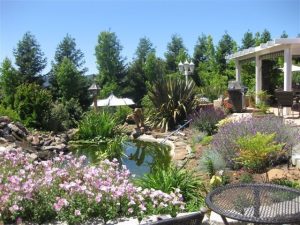As discussed in the previous article, vertical overlapping layers of vegetation are a basic premise for the habitat garden. Birds use all layers. Each species shows preference for which layer is best for perching, foraging, and nesting. Any plant that is good habitat for insects will provide most of the food needed for the songbird species. With the exception of goldfinches and California Towhees, that are primarily seed-eating species, many bird species are omnivores. They eat insects and seeds, fruit, and nuts. Native trees and shrubs support a high number of insects that birds feed on making them an essential part of the wildlife garden.
Trees and shrubs such as toyon, blue elderberry, hollyleaf cherry, and coffeeberry are all native to California and will grow well in this area. These plants will feed many birds from summer into winter months. Blue elderberry, with its nectar-rich flowers in spring, attracts pollinators and many songbirds love the dark blue berries that follow. Hollyleaf cherry and coffeeberry provide nectar flowers in summer and berries in summer and fall; both attract beneficial insects. Toyon provides berries from fall into winter.
Oregon grape as a low growing hedge or mounding groundcover is an excellent choice for the habitat garden. The plant is drought tolerant, easy to grow in most soils, provides cover and foraging sites and birds love the berries.
Hedgerows are making a comeback in this country. Traditionally seen in the English countryside, they were once common here, too, before they were replaced by fences. Though hedgerows have many useful functions in the landscape, they are of enormous benefit to wildlife. They provide dense cover, multiple nesting sites, and a diversity of seasonal food sources for birds like quail, towhees, and dark eyed juncos. When considering what plants to use in your hedgerow, think about the height and width you desire or your garden will allow, the function in your landscape, and the soil and climate. Also consider evergreen plants as a good location for birds to shelter all year long, and think about staggering bloom times within the mix of plants to increase wildlife value year-round. A mixture of manzanita, Ceanothus, hollyleaf cherry, coffeeberry, Mexican elderberry, toyon, and coyote bush will take you through the entire year with something edible for wildlife. Three native evergreen shrubs – coffeeberry, ceanothus and coyote bush—make an attractive combination. All three bring in many kinds of insects, which in turn feeds in birds and beneficial insects.*
In my upcoming article I will continue with the habitat garden theme, and delve further into the needs of hummingbirds in the garden.
*Bauer, Nancy The California Wildlife Habitat Garden, University of California Press 2012
Wendy Weidenman is a University of California Cooperative Extension Master Gardener of Tuolumne County. UCCE Master Gardeners of Tuolumne County can answer home gardening questions. Call 209-533-5912 or go to: http://ucanr.edu/survey/survey.cfm?surveynumber=7269 to fill out our easy-to-use problem questionnaire. Check out our website at: http://cecentralsierra.ucanr.edu/Master_Gardeners/ You can also find us on Facebook or pick up the local UCCE Master Gardener book “Sharing the Knowledge: Gardening in the Mother Lode” at Mountain Books or the UCCE Office both in Sonora, CA


